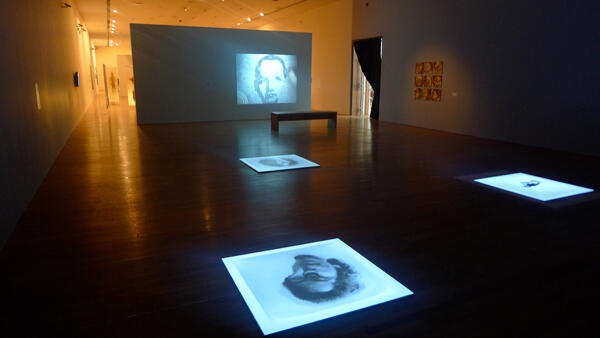Oscar Muñoz/Protografías
Museo de Arte del Banco de la República
The itinerant exhibition “Oscar Muñoz/Protografías”, which ended in March at the Art Museum of the Banco de la República in Bogotá, Colombia, and will later travel to the Lima Art Museum (Mali), Lima, Peru; to the Museum of Latin American Art (MALBA), Buenos Aires, Argentina; to the Antioquia Museum, Medellín, Colombia, originated at the Art Museum of the Banco de la República in Bogotá, and was curated by José Roca and María Wills (adjunct curator). The retrospective includes over thirty-five works – among them drawings, videos, and installations – produced by the Colombian artist since the 1960s.

The structuring tension of the exhibition organized between the thematic perspective around the concept of “Protografía” and the chronologic perspective, allows us to recognize the rich experimentation and continuous search in Muñoz’s artistic process and, at the same time, the intricate relationship that exists between his artistic exploration and questions of a social and existential nature. Among the permanent questionings in the artist’s work the following may be highlighted: the capacity of the visual image to perceive the human reality; the possibility of recognizing ourselves in the others and of knowing who we are; the sense of memories and of the personal and collective history; the play of probabilities that life implies, and the certainty concerning its ending.
The variety and the nuances of such questionings are evident in the different halls, organized according to the subthemes. The theme of the first hall, “Caleidoscopios/fragmentos de ciudad”, assembles works from various times in which the artist (born in Popayán en 1951) focuses on the transformations of Cali, where he lives and works. An aerial photograph of the city on which the viewers walk ( Ambulatorio) offers a macro vision, whereas the perception of details, signs, reflections and atmospheres of interior urban spaces (series Interiores and A través del cristal) allows the viewer to obtain a more intimate vision. On an intermediate plane between these two visions, the photographs of passers-by included in Archivo por contacto and in a video projected on the river Cali, El Puente, show scenes of the past in which the citizens may find and recognize themselves.
During the 1980s, Muñoz started to experiment with new supports, processes and materials. As a consequence, in the series Superficies al carbón he succeeded in achieving as a final result a random product of the interaction between the materials he used (charcoal, gypsum and water) and the atmospheric conditions. In the second hall, entitled “El soporte reconsiderado” similar works are assembled – like in the series Narcisos – a product of water evaporation and the disfigurement of self-portraits drawn with charcoal powder. Works such as these allow the viewers to interact with themselves and with others through images and the reflections on water, metallic (Aliento), or plastic ( Las cortinas de baño) surfaces.
In spite of the changing nature of many of these works, a third hall is specifically devoted to the “Imagen inestable” (Unstable image). In works like Biografías, Línea del destino and Re/trato, the artist utilizes a new medium, video, to capture the permanent transformation of the images subjected to the effects of gravity or heat.
The fourth hall entitled “Antimonumentos”, features Proyecto para un Memorial: a series of videos that allude to the need and the difficulty to remember and pay homage to absent or missing persons through drawings-portraits with water on rocks exposed to the sun.
The intimate relationship between life and death, memories and oblivion is dealt with from the personal and historic dimensions in the works collected in the hall of the “Improntas”. The first are evidenced in the photographs of a mortuary mask of the artist in La mirada del cíclope, as well as in the self-portraits that gradually lose definition as Muñoz burns them with his cigarette ( Mientras fumo). As a counterpoint to this personal life experience, Muñoz explores in works such as Impresiones débiles, Paistiempo y Pixeles the fading away of the images – both in the memory and in the works – of traumatic events of the Colombian past.
In recent works exhibited in the last hall under the concept of “Imagen en flujo” (Flowing image), the changing character of memory, identity and life is explored from new and sharp angles. In some cases, chemical processes such as oxidation ( Ante la imagen) or development of photographs ( Sedimentaciones) are in charge of producing and devouring portraits. In others, like in Palimpsesto, the viewers may see themselves reflected from several perspectives while they find, simultaneously, the face of other visitors. Finally, in Fondo blanco it is possible to attend multiple and diverse moments of a photograph of the artist’s mother and of a video-portrait of his father, whose fluctuating breathing is also heard.
The concept of “Protografía”, core of the curatorial proposal, highlights this permanent insistence of Muñoz on the exploration of the moments before and after the fixation of the image on a support or, in other words, on the vital process of the images. One of the implications of such proposal, as suggested by the introductory work of this exhibition, El juego de las probabilidades (2007), is the artist’s confrontation with the limits inherent in any visual image that pretends to represent life and reality in a static way. As alternatives, since the beginning of his career but in a more defined way since de 1980s, Muñoz explores and discovers both the expressive capacity and the symbolic load of materials, substances, reflections and physical processes. His constant exploration of these offers invaluable keys for assuming our existence and understanding ourselves in terms of realities which are always dynamic, conditioned and contingent.







